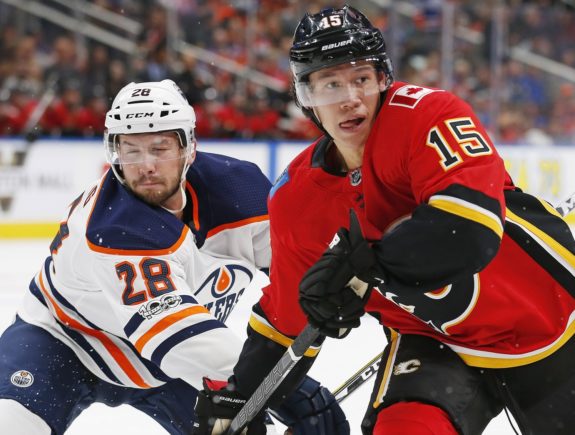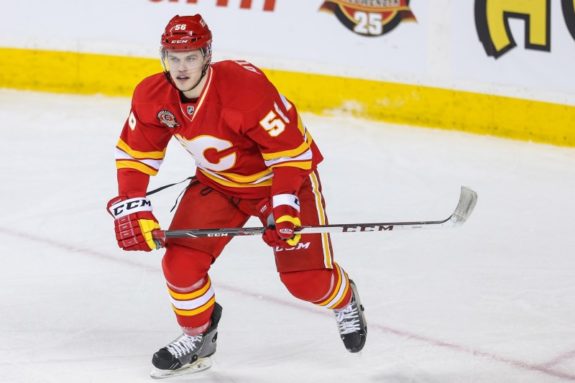In the National Hockey League, the separation between the really good and really bad teams isn’t all that pronounced and the difference between the good teams is often razor-thin. This balance is particularly pronounced in the postseason, when many teams’ best lines are cancelled out by their opposition, leaving the balance of the series to be swung by their depth players. Often, the team with the best third and fourth lines – or the least drop-off between their top lines and those beneath them – prevails in a playoff series.

For the Calgary Flames, the summer of 2017 was in many ways a response to the challenges they had last season when they played the Edmonton Oilers in the regular season and the Anaheim Ducks in the regular season and playoffs. The Flames just didn’t quite have the guns to go at it with strong teams, especially when it came down to their third and fourth line or third defensive pairing.
A Summer of Flames Changes
Compared to last fall, the Flames have a much different group at training camp. They’ve added a pair of blueliners in first round selection Juuso Valimaki and depth signing Matt Bartkowski, and some interesting forwards in Curtis Lazar, Spencer Foo and professional try-out players Tanner Glass and Joseph Cramarossa. Adding to the competitive pool of players pushing for NHL jobs has been the improvements of young prospects such as Mark Jankowski, Andrew Mangiapane, Brett Kulak and Rasmus Andersson, as well as the resurgence of oft-forgotten prospects Morgan Klimchuk and Emile Poirier.
As a result of these additions and improvements, arguably more players than can be recalled in recent memory entered Flames camp with a realistic chance of NHL employment at the end of it.
An Autumn of NHL Opportunity
The Flames’ top six is basically locked down with Sean Monahan in-between Johnny Gaudreau and Micheal Ferland, and the fabled 3M Line of Matthew Tkachuk, Mikael Backlund and Michael Frolik remaining together. Four of the team’s bottom six forward jobs are essentially locked down with Kris Versteeg, Sam Bennett, Matt Stajan and Troy Brouwer. That leaves two “regular” forward jobs available and up to two spots in the press box up for grabs. On the blueline, five of seven defensive jobs are taken by Mark Giordano, Dougie Hamilton, T.J. Brodie, Travis Hamonic and Michael Stone. That leaves two jobs up for grabs.

That leaves four forward spots and two defensive spots potentially open, exclusively in the bottom half of the team’s roster. Given the Flames’ struggles in the postseason with Anaheim’s depth players out-dueling their own depth players, the decisions on which individuals slot into the open spots are very important. And because of the changes and improvements within the organization since the spring, the Flames arguably have more players to choose from and tougher decisions to make than they have in the past.
The Challenge of Picking The Right Players
The Flames have approximately 10 players to choose from when it comes to the four forward jobs. Curtis Lazar, Garnet Hathaway and Freddie Hamilton are all right-shooting forwards (Lazar and Hamilton can play center), and all spent time on the Flames roster last season. That said, all three are arguably fringe players who haven’t cemented themselves onto the NHL roster as of yet. They’re being pushed by players like Jankowski, Foo, Mangiapane, Klimchuk and Poirier from within the Flames system and Cramarossa and Glass from outside of it. It’s unlikely that the Flames will keep prospects on their roster if they’re not going to play a regular shift, so that arguably gives Hamilton, Cramarossa, Hathaway, Lazar and Glass an edge – their development won’t be stifled if they have to sit in the press box.
On the blueline, the Flames’ choices are no less plentiful: Valimaki, Bartkowski, Kulak and Andersson being joined by Tyler Wotherspoon and Oliver Kylington in pushing for jobs. Bartkowski and Wotherspoon are arguably the closest to finished products developmentally, which potentially gives them a shot at least at being the extra defender in the press box. The X-factor here may be the Vegas Golden Knights; the expansion club selected a ton of defenders in the expansion draft, many of which would require waivers to be assigned to the American Hockey League. The possibility exists that the Flames may find an upgrade on one of their internal options via the waiver wire.
All-told, the Flames’ off-season moves and the progression by their own young players have given them a ton of choices to make before rosters are cemented on Oct. 3. It’s up to the many, many players in the mix for NHL jobs to convince management that they’ve made the correct choices as the season moves forward. The selection of the bottom half of the team roster may seem mundane in the grand scheme of things, but their impact in the tightly-contested playoff series shows that these tiny decisions can have immense consequences on a season.